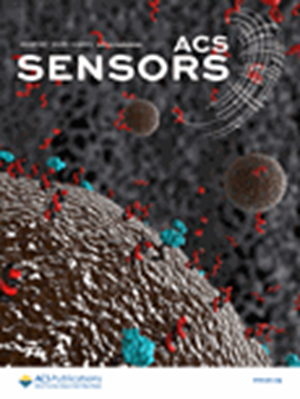Know Your Sensor and Know Your Sample
IF 9.1
1区 化学
Q1 CHEMISTRY, ANALYTICAL
引用次数: 0
Abstract
I am writing this piece to urge you to properly understand the sensing principle you are developing as well as the application you have in mind. Please know your sensor and your sample. In my role as Executive Editor of ACS Sensors, I see many submitted works where neither the sensing mechanism nor the analytical problem is properly understood or studied. Please spend time on the problem you aim to solve. This is a real opportunity, not an unnecessary burden, and should be seen as enriching. Chemistry is the science of change. Chemical and biochemical transformations occur in most samples of practical relevance and tracking them with sensors is an amazing opportunity to further our understanding of complex systems. Aquatic environments, for example, exhibit chemical gradients and temporal fluctuations driven by temperature, salinity, sunlight, bioactivity, exchange with the atmosphere, mixing, and interactions with colloidal and polymeric matter in addition to small molecules. Metal species may change their redox state, their chemical speciation through complexation, precipitation, adsorption, and bio-uptake. Organic pollutants are chemically transformed, taken up, adsorbed, and decomposed. In living systems, drugs are metabolized, ions fluctuate in space and time, chemical and biological species form gradients and compartmentalize, cells may rupture and change the sample environment, and the sensor itself can be attacked and fouled. Yes, these processes are challenging to understand but form an integral part of serious sensor research. But sensors and integrated assays should also be characterized and mechanistically understood in view of the analytical problem. Why is that? Some probes may be based on equilibrium interactions and tend to respond exclusively to a particular equilibrium species that interacts with the sensing species or surface. Other principles, as often encountered with dynamic electrochemistry, are mass-transport limited. Here, the reacting species can normally not be chemically isolated from other chemical forms that rapidly interconvert on the time scale of the experiment. This changes the chemical information the sensor will report on. A third class, as with many spectroscopic and separation principles, but also affinity assays and reaction-based molecular indicators, is based on a complete chemical or biological isolation or transformation. Here, information on chemical speciation tends to be all but lost unless special precautions are taken. So, do you know what information your sensor gives you? Is this information adequate for the system you aim to study? What reference method and what conditions should one choose to best correlate two different techniques? Please spend time on these important questions and do not just spike a target sample with the analyte of interest to call it a day. Yes, one should aim for adequate selectivity and sensitivity. But knowing what you measure and taking the complexities of your sample seriously will help your research to have real impact. And this should be our goal, not just to produce an academic paper. This article has not yet been cited by other publications.了解传感器和样品
我写这篇文章的目的是敦促您正确理解您正在开发的传感原理以及您心目中的应用。请了解您的传感器和样品。作为《ACS 传感器》杂志的执行编辑,我看到许多提交的作品都没有正确理解或研究传感机制或分析问题。请花时间研究您要解决的问题。这是一个真正的机会,而不是不必要的负担,应将其视为一种充实。化学是研究变化的科学。大多数具有实际意义的样本中都会发生化学和生物化学变化,使用传感器跟踪这些变化是我们进一步了解复杂系统的绝佳机会。例如,水生环境会在温度、盐度、阳光、生物活性、与大气交换、混合以及与胶体和聚合物质(以及小分子)相互作用的驱动下,呈现出化学梯度和时间波动。金属物种可能会通过络合、沉淀、吸附和生物吸收等方式改变其氧化还原状态和化学式。有机污染物会发生化学转化、吸收、吸附和分解。在生物系统中,药物会发生新陈代谢,离子会在空间和时间上发生波动,化学和生物物种会形成梯度和区隔,细胞可能会破裂并改变样本环境,传感器本身也会受到攻击和堵塞。是的,这些过程都很难理解,但却是传感器研究不可或缺的一部分。但是,鉴于分析问题,传感器和集成检测方法也应具有特性,并从机理上加以理解。这是为什么呢?有些探头可能是基于平衡相互作用,倾向于只对与传感物种或表面相互作用的特定平衡物种做出反应。其他原理,如在动态电化学中经常遇到的,则受质量传输的限制。在这种情况下,发生反应的物种通常无法从化学上与其他化学形式隔离开来,而其他化学形式会在实验的时间尺度内迅速发生相互转化。这就改变了传感器将报告的化学信息。第三类是基于完全的化学或生物分离或转化,如许多光谱和分离原理,也包括亲和力检测和基于反应的分子指示器。在这种情况下,除非采取特别的预防措施,否则有关化学标本的信息往往会丢失殆尽。那么,您知道您的传感器能提供哪些信息吗?这些信息对于您要研究的系统是否足够?应该选择什么样的参考方法和条件才能最好地将两种不同的技术联系起来?请在这些重要问题上花些时间,不要只在目标样品中添加感兴趣的分析物就了事。是的,我们应该追求足够的选择性和灵敏度。但是,了解您测量的是什么,并认真对待样品的复杂性,将有助于您的研究产生真正的影响。这应该是我们的目标,而不仅仅是发表一篇学术论文。本文尚未被其他出版物引用。
本文章由计算机程序翻译,如有差异,请以英文原文为准。
求助全文
约1分钟内获得全文
求助全文
来源期刊

ACS Sensors
Chemical Engineering-Bioengineering
CiteScore
14.50
自引率
3.40%
发文量
372
期刊介绍:
ACS Sensors is a peer-reviewed research journal that focuses on the dissemination of new and original knowledge in the field of sensor science, particularly those that selectively sense chemical or biological species or processes. The journal covers a broad range of topics, including but not limited to biosensors, chemical sensors, gas sensors, intracellular sensors, single molecule sensors, cell chips, and microfluidic devices. It aims to publish articles that address conceptual advances in sensing technology applicable to various types of analytes or application papers that report on the use of existing sensing concepts in new ways or for new analytes.
 求助内容:
求助内容: 应助结果提醒方式:
应助结果提醒方式:


